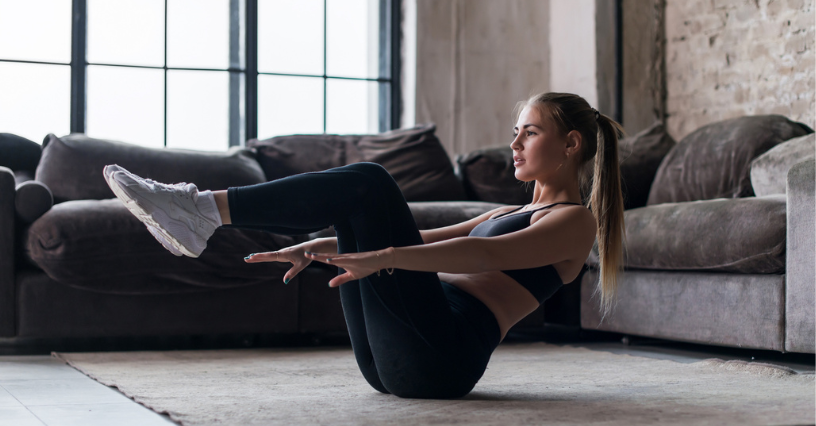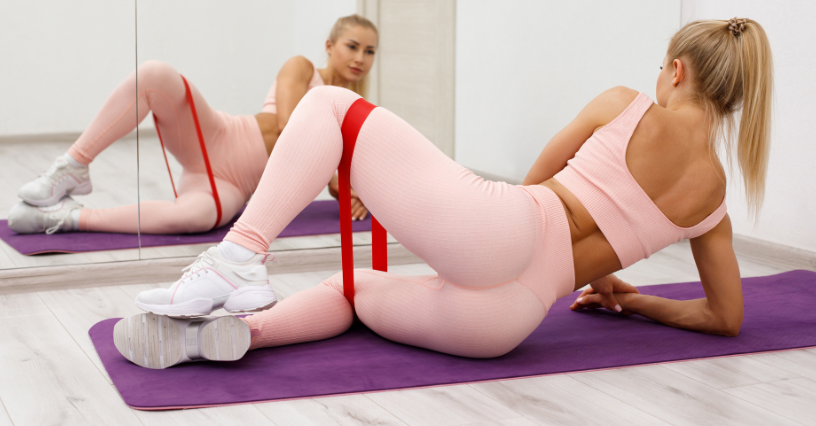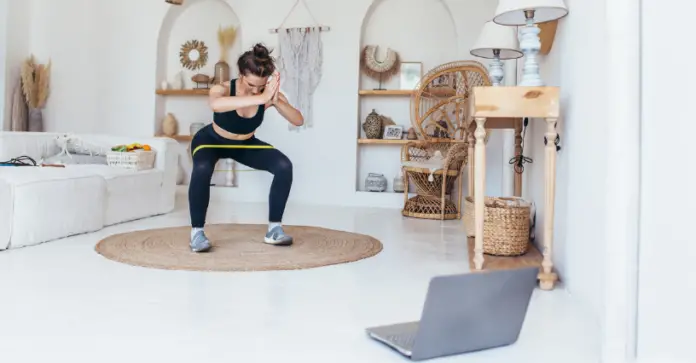Strength training at home is a simple and convenient way to maintain a workout routine when you can’t go to the gym or are a beginner.
We suggest which strength training exercises without equipment, with elastic bands or with dumbbells to do at home to develop your strength, muscle mass and endurance, to sculpt your figure or to lose excess pounds.
Strength training at home – the most important indications
Strength training, also called resistance training , is a versatile form of physical exercise associated primarily with the gym and specialized equipment or with continuous lifting, barbell squeezing, or deadlifts.
Meanwhile, strength training can be done virtually anywhere and without equipment – just with your own body weight.
Before starting strength training at home, consult your doctor about possible contraindications, such as cardiovascular problems, musculoskeletal injuries (fractures, etc.), rheumatoid arthritis, or pregnancy and the postnatal period.
The next step will be to set up a suitable space where you can exercise comfortably. You should have enough room to move your arms and legs freely.
Try to exercise away from furniture, equipment, or objects that could become entangled or dangerous (for example, you could trip, bump, or snag on them). Also consider space for an exercise mat and any weights.
If you’re new to your strength training adventure, set small, achievable goals to avoid discouragement with poorly chosen exercises and loads, overtraining, and accidents.
You can consult a personal trainer who will tell you how to perform certain exercises correctly or what weight to choose according to your level of physical training, body part, etc.
Don’t forget to wear comfortable and functional sportswear made of breathable materials that allow freedom of movement. It’s a good idea to keep track of your progress with a training log where you write down, for example, repetitions, weights, etc.

What equipment is needed for resistance training at home?
You don’t need to invest in heavy and bulky equipment, but it’s worth buying a few items to improve your training and get better results. For strength training at home, it is worth buying:
- exercise mat ;
- resistance bands (eg mini band, power band), tubing or expanders ;
- dumbbells ;
- kettlebell;
- gym ball .
If you are a beginner, a body weight or weights of 0.5-1.5 kg will be enough to start, so that you can effectively master the correct technique for performing individual weights.
Intermediate and advanced people should opt for weight sets that will allow them to progress, adapting the weight to the muscle part and training goals. Choose a weight or resistance level so that you feel fatigued after 12-15 reps (you should feel like you can’t do another rep).
If you can easily do several repetitions of an exercise, gradually increase the weight or resistance.
Hint: You can successfully replace the weights with water bottles (eg 0.5-2 l) or a 5 l water bottle.
How to prepare for strength training at home?
Start by creating a training plan and setting a training goal, as well as how often and how you will exercise. Strength training can take the form of:
- circuit training – consists of so-called circuits, i.e. a series of 8-12 exercises performed one after the other with a short break or intervals and involving all parts of the body. You can work for time (for example 45/15 or 50/10) or do a certain number of repetitions of a certain exercise ;
- the split – Alternatively, split training consists of concentrating in one training unit exclusively on a certain part of the body, for example legs, back and shoulders, chest and triceps. It is perfect for people with long training experience and adequate knowledge, who focus on bodybuilding, for example for bodybuilding competitions ;
- FBW (Full Body Workout) – a training method that is good for beginners. It is general in nature and consists of multi-joint exercises, allowing you to focus on training your entire body. It involves performing an exercise for each specific part of the body, starting with the largest – legs, back and chest – and gradually moving to the smallest – shoulders, triceps, biceps and abdomen .
- walking or stomping on the spot
- swing arms forward/backward
- hip rotation
- trunk rotation
- forward/side/back leg movement
- lunge
- squats
- alternating jumps with arms up (right hand + left knee and vice versa)
- jumping jack
- skip A/C
- ” quick feet ” ( quick running on the spot )
- rope ( without equipment or with a jump rope, if you have one and have enough space ).
Every home strength training session should begin with a warm-up. Spend 10-15 minutes preparing your muscles, ligaments and tendons for increased work, to reduce the risk of injury or premature termination of exercise due to the fact that your body has entered into intensive work from the very beginning and therefore has a lower capacity for effort (you tire more quickly). Performs:
If you have a stationary bike, treadmill or elliptical at home, you can spend 5 minutes warming up on the machine and then go through the list above.
At the end of strength training, it’s worth remembering to stretch and roll your muscles to speed up post-workout recovery, keep your fitness high, as well as calm your body and restore your pre-workout balance training. For details, see our post-workout stretching and muscle rolling guides.
How often to train at home?
To achieve the desired results, it is best to strength train at least 3 times a week. It is a good idea to establish the order of 1 day of training – 1 day of rest in your training plan.
For example, Monday-Wednesday-Friday or Tuesday-Thursday-Saturday are training days and the rest are recovery days or other activities such as stretching, yoga, mobility, pilates, recreational swimming or light cardio between 60-75% from the maximum heart rate (the easiest way to calculate this is using the formula: HRmax = 220-age ).

Strength training at home without equipment
Strength training doesn’t have to mean lifting tons of weights and working out on specialized machines. In the comfort of your own home, you can develop well-defined muscles and adequate strength using only your own body weight. Especially beginners should opt for this so that they can first focus on correct technique, fluidity of movements, stable position and complete control of efforts.
Strength training at home without equipment – trial exercises:
- squats – position your feet shoulder-width apart, with your toes slightly pointing outwards. Squeeze your shoulder blades together and straighten your back. Inhale and begin to bend your hips and knees simultaneously. Drop down to a range that is comfortable for you. Avoid pushing your knees forward and dropping them inward (point them toward the toes of 1-2 feet), as well as excessive trunk bending (keep your chest open, look straight ahead). Read more in the guide : Squats ;
- classic push-ups, kneeling, or hands on a height/wall – Position your hands slightly wider than your shoulders, feet together, buttocks tight, belly button towards the spine, body forming a single line. Inhale and begin to lower your body steadily towards the floor, while bringing your elbows towards your body so that they form an angle of about 45 degrees. Read more in the article types of floats ;
- plank (forearm plank) – Position yourself on your forearms so that your elbows are under your shoulders. Keep your feet together or hip-width apart. Squeeze your buttocks, with the navel pointing towards the spine, so that your body forms a single line and the lumbar region does not run down. Stay in this position for 30-60 seconds (depending on your training level). In a more difficult variation, go from the low plank position to the high plank position, that is, put your hands under your shoulders and return to the starting position ;
- jumping jacks – Stand with your feet hip-width apart, place your hands along your torso or rest on your hips. Take a big step forward with your right leg and, bending the leg at the knee, lower the position so that your right thigh is parallel to the floor. Push off your heels and return to the starting position. Repeat with the left leg ;
- pull knees to chest in the supine position – Sit on a mat, bend your legs at the knees and support yourself with your arms (place them behind you). Raise your legs and begin to alternately pull the knee towards the chest. You can also do both knees at the same time ;
- Dumbbell Overhead Press – Stand with them shoulder-width apart. Raise your arms bent at the elbows to the sides, at chest height, so that there is a right angle between the shoulder and the forearm, and the palms are facing up. Press the dumbbells over the top of the head (don’t hit the weights against each other) and return to the starting position ;
- stretches – lying on your back on a mat or upright bench, position your hands with dumbbells above your chest (palms facing in). Arms slightly bent at the elbows. Back neutral, legs bent at knees, feet hip-width apart. You begin to lower your arms to the floor until your elbow is on the floor or below the line of the bench (keep the angle of flexion at the elbow constant) – you should feel your chest stretch. Return to the starting position ;
- Rowing – Feet shoulder-width apart, arms along torso, back straight, shoulder blades pulled back. Bending at the hips, lower your torso parallel to the floor and begin rowing with your elbows close to your body behind you and your hands with weights at hip height. ;
- French supine presses – Lie on your back, feet hip-width apart, back neutral. Place your hands with the weight at chest height and point the round part of the dumbbell towards you. Bending your arms at the elbows, you begin to lower your hands until they are at the level of your forehead. Straighten your arms and return to the starting position (avoid bending your elbows too far).
Exercises with dumbbells at home
With dumbbells you can expand the range of exercises at home. A functional solution is the adjustable dumbbell set, which consists of two bars, snaps and several pairs of weights, so that you can freely change the weight according to your needs and the muscle group you are exercising, or to combine dumbbells with a dedicated barbell.
Exercises with dumbbells at home – examples:
- single leg raise (so-called swallow) – Position your feet hip-width apart, hands with dumbbells along your torso. Back straight, shoulder blades tight. You begin to bend at the hips and at the same time, slightly bend your right knee and lift your left leg up towards your back. Lower your torso down until you feel a stretch in the area of the biceps femoris muscles (back strap) or reach a position where your torso is parallel to the floor
- Lunges – Stand hip-width apart with your arms along your torso. Chest thrust forward, back straight, shoulder blades pulled back, buttocks and abdomen tight. Step back and bend your legs at the knees so that both legs (curled and planted) are at a right angle between the thigh and the shin. Don’t lean your torso forward. Exhale, transfer your weight to the stepping leg and return to the starting position.
- Dumbbell Overhead Press – Stand with them shoulder-width apart. Raise your arms bent at the elbows to the sides, at chest height, so that there is a right angle between the shoulder and the forearm, and the palms are facing up. Press the dumbbells over the top of your head (do not slam the weights against each other) and return to the starting position;
- stretches – lying on your back on a mat or upright bench, position your hands with dumbbells above your chest (palms facing in). Arms slightly bent at the elbows. Back neutral, legs bent at knees, feet hip-width apart. You begin to lower your arms to the floor until your elbow is on the floor or below the line of the bench (keep the angle of flexion at the elbow constant) – you should feel your chest stretch. Return to starting position;
- Rowing – Feet shoulder-width apart, arms along torso, back straight, shoulder blades pulled back. Bending at the hips, lower your torso parallel to the floor and begin rowing with your elbows close to your body behind you and your hands with weights at hip height.;
- French supine presses – Lie on your back, feet hip-width apart, back neutral. Place your hands with the weight at chest height and point the round part of the dumbbell towards you. Bending your arms at the elbows, you begin to lower your hands until they are at the level of your forehead. Straighten your arms and return to the starting position (avoid bending your elbows too far).
Dumbbells made of cast iron, adjustable, vinyl, neoprene, bitumen or chromed steel from renowned manufacturers such as: Body Sculpture, HMS, Kettler, Technogym, THORN FIT, Spokey or TREXO , you can find them on Sportano.ro .

Resistance training at home
Resistance bands such as mini bands and power bands, tubbing and expanders are a great addition to strength training that targets both the upper and lower body. It is essential to find the right resistor, which is usually indicated by a color or painted rectangle markings.
Resistance training at home – examples of exercises with mini bands:
- monster walk – put a mini band above your knees. Feet hip-width apart. Bend at the hips and lower into a half squat. Navel pulled in, back straight. Carrying out the movement from the knees, take small steps 5 times to the right side, placing the legs parallel to each other, then turn around .
- glutes bridge – lie on your back, feet hip-width apart, heel under knee. Point your navel towards your spine, avoid bending your lumbar region. Raise the hips up until the hip joint is straight, squeeze the buttocks and hold the position for a moment. You start to lower your hips until you are 2-3 cm above the floor .
- seated one-arm row – sit on the mat. Straight legs with shoulder blades pulled back. Place the mini band on the metatarsal of your right foot and grasp the other end with your right hand. Pulling the hand to the line of the lower ribs, perform a rotation – palm facing the ceiling with the inside of the hand. Return to the starting position keeping the band slightly stretched .
- mountain climber with bands on your feet – put a mini band on your metatarsals and get into a high plank position. Alternately pull the knee towards the chest for 30-45 seconds .
Strength training at home – effects
Adding strength training to your weekly workout plan will have many health and fitness benefits, while also saving you time and money on gym trips and memberships. However, to get the right results, it is important to remember the regularity and the fact that everyone will change at an individual rate. Generally, after a month of regular strength training (2-3 times a week), you will see measurable benefits.
What effects does strength training have?
- building lean muscle mass ;
- fat reduction (including visceral fat stored in the abdominal cavity and internal organs) and weight loss (if proper eating habits are maintained) ;
- it boosts metabolism – including resting metabolism, i.e. increased calorie burning even when you’re not exercising. It can last up to 72 hours – depending on the intensity of the exercise and the body parts involved ;
- strengthening the heart and circulatory system ;
- increase in bone density ;
- improving flexibility, range of motion and balance ;
- slimming and sculpting the silhouette ;
- increasing muscle strength and endurance ;
- firmer skin and reduction of cellulite visibility ;
- a better condition ;
- reduction of LDL cholesterol and blood sugar levels ;
- stabilization and strengthening of deep muscles, thus improving posture ;
- improvement of condition ;
- stress reduction ;
- a better quality of sleep ;
- improving libido ;
- higher self-esteem .



